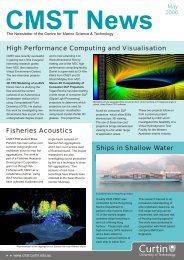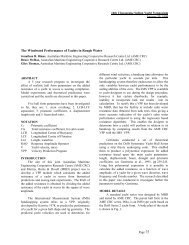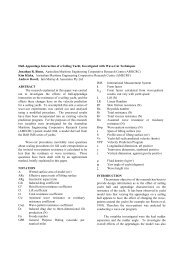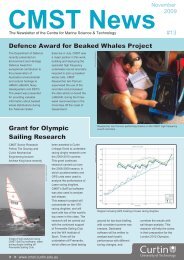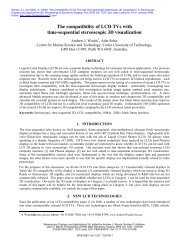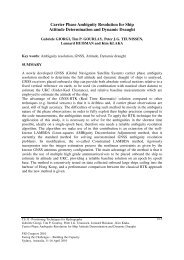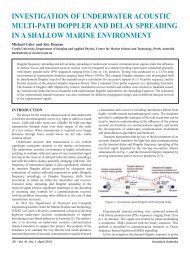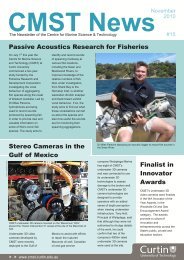Blue whale calling in the Rottnest trench-2000, Western ... - ANP
Blue whale calling in the Rottnest trench-2000, Western ... - ANP
Blue whale calling in the Rottnest trench-2000, Western ... - ANP
Create successful ePaper yourself
Turn your PDF publications into a flip-book with our unique Google optimized e-Paper software.
Figure 39: Error between manual count of number of callers m<strong>in</strong>us automatic count of number of callers, for 501<br />
blocks of <strong>the</strong> bluey logger (blocks 500 to 1000).<br />
3.8) <strong>Blue</strong> <strong>whale</strong> <strong>call<strong>in</strong>g</strong> through time:<br />
The presence of <strong>call<strong>in</strong>g</strong> blue <strong>whale</strong>s throughout <strong>the</strong> study period from all record<strong>in</strong>g sequences is<br />
summarised on Table 4. To correlate this with <strong>the</strong> sight<strong>in</strong>gs made from aerial surveys and boat<br />
based studies, <strong>the</strong> survey effort and blue <strong>whale</strong> sight<strong>in</strong>gs for <strong>the</strong> visual surveys are given on<br />
Table 5. The characteristic blue <strong>whale</strong> calls were first detected on <strong>the</strong> 13th of January (sample set<br />
2460 is yet to be worked up) by <strong>the</strong> drift<strong>in</strong>g gear. These calls were low level (< 96 dB re 1μPa<br />
msp) and estimated to be at > 40 km range. Thus <strong>the</strong>y were most likely not <strong>in</strong> <strong>the</strong> <strong>Rottnest</strong> <strong>trench</strong><br />
region. The first drift<strong>in</strong>g set with calls from animals estimated to be <strong>in</strong> <strong>the</strong> <strong>Rottnest</strong> <strong>trench</strong> were<br />
those of set 2463 on <strong>the</strong> 29th January where animals with<strong>in</strong> 40 km of <strong>the</strong> eastern head of <strong>the</strong><br />
<strong>trench</strong> were recorded. The number of callers and <strong>the</strong> received level of <strong>the</strong> type II component for<br />
<strong>the</strong> 29th Jan drift<strong>in</strong>g set 2463 are shown on Figure 40, from which it can be seen that mostly one,<br />
but occasionally two callers were heard and a large break <strong>in</strong> <strong>call<strong>in</strong>g</strong> occurred. <strong>Blue</strong> <strong>whale</strong>s were<br />
<strong>the</strong>n sighted consistently by <strong>the</strong> boat based surveys and aerial surveys (seven sighted on 2nd Feb)<br />
throughout February, with <strong>the</strong> daytime drift<strong>in</strong>g record<strong>in</strong>gs pick<strong>in</strong>g up <strong>whale</strong>s with<strong>in</strong> (set 2468,<br />
2469 27-28th Feb) and outside <strong>the</strong> <strong>trench</strong> region. The bluey logger consistently recorded near<br />
and distant blue <strong>whale</strong>s from <strong>the</strong> day it was deployed (8th March) until <strong>the</strong> day it was recovered<br />
(10th April).<br />
The bluey logger set was analysed manually for <strong>the</strong> number of <strong>call<strong>in</strong>g</strong> blue <strong>whale</strong>s for <strong>the</strong> first<br />
998 records (or week 8-14th March). The <strong>in</strong>cidence of vessel passage and <strong>the</strong> 20 Hz 'click<strong>in</strong>g'<br />
was noted. The level of all blue <strong>whale</strong> components which could be analysed (no overlapp<strong>in</strong>g<br />
components, compet<strong>in</strong>g shipp<strong>in</strong>g or 20 Hz click<strong>in</strong>g) was obta<strong>in</strong>ed, as was <strong>the</strong> maximum peakpeak<br />
level of <strong>the</strong> 20 Hz click<strong>in</strong>g for each block with <strong>the</strong> click<strong>in</strong>g present. The number of <strong>call<strong>in</strong>g</strong><br />
blue <strong>whale</strong>s (averaged <strong>in</strong> 2 hour blocks or 12 po<strong>in</strong>ts per average), presence of shipp<strong>in</strong>g, <strong>the</strong><br />
maximum peak-peak level of <strong>the</strong> 20 Hz click<strong>in</strong>g and <strong>the</strong> level of <strong>the</strong> type II components which<br />
could be analysed, for this week are shown on Figure 41. The maximum number of <strong>call<strong>in</strong>g</strong><br />
animals <strong>in</strong> any given block was n<strong>in</strong>e, although <strong>the</strong> mean was much less at 2.0 ± 0.10 (mean ±<br />
95% confidence limits). The distribution of <strong>the</strong> number of callers measured is shown on Figure<br />
42. The number of <strong>call<strong>in</strong>g</strong> blue <strong>whale</strong>s shows a def<strong>in</strong>itive daily pattern with more <strong>call<strong>in</strong>g</strong> at night<br />
than dur<strong>in</strong>g <strong>the</strong> daytime. A power spectrum of <strong>the</strong> number of <strong>call<strong>in</strong>g</strong> animals with time showed a<br />
strong peak at 24 hours. Us<strong>in</strong>g <strong>the</strong> data from this set <strong>the</strong>n night time <strong>call<strong>in</strong>g</strong> (over 20:00 - 04:00)<br />
was 2.2 ± 0.92 times (mean ± 95% confidence limits) greater than daytime <strong>call<strong>in</strong>g</strong> (over 08:00 -<br />
38



